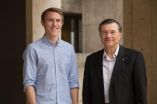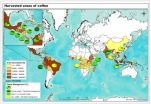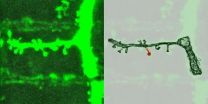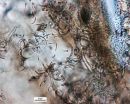(Press-News.org) LA JOLLA—Scientists at the Salk Institute have created a new model of memory that explains how neurons retain select memories a few hours after an event.
This new framework provides a more complete picture of how memory works, which can inform research into disorders liked Parkinson's, Alzheimer's, post-traumatic stress and learning disabilities.
"Previous models of memory were based on fast activity patterns," says Terry Sejnowski, holder of Salk's Francis Crick Chair and a Howard Hughes Medical Institute Investigator. "Our new model of memory makes it possible to integrate experiences over hours rather than moments."
Over the past few decades, neuroscientists have revealed much about how long-term memories are stored. For significant events—for example, being bit by a dog—a number of proteins are quickly made in activated brain cells to create the new memories. Some of these proteins linger for a few hours at specific places on specific neurons before breaking down.
This series of biochemical events allow us to remember important details about that event—such as, in the case of the dog bite, which dog, where it was located, if it required an emergency room visit, and so on.
One problem scientists have had with modeling memory storage is explaining why only selective details and not everything in that 1-2 hour window is strongly remembered. By incorporating data from previous literature, Sejnowski and first author Cian O'Donnell, a Salk postdoctoral researcher, developed a model that bridges findings from both molecular and systems observations of memory to explain how this 1-2 hour memory window works. The work is detailed in the latest issue of Neuron.
Using computational modeling, O'Donnell and Sejnowski show that, despite the proteins being available to a number of neurons in a given circuit, memories are retained when subsequent events activate the same neurons as the original event. The scientists found that the spatial positioning of proteins at both specific neurons and at specific areas around these neurons predicts which memories are recorded. This spatial patterning framework successfully predicts memory retention as a mathematical function of time and location overlap.
"One thing this study does is link what's happing in memory formation at the cellular level to the systems level," says O'Donnell. "That the time window is important was already established; we worked out how the content could also determine whether memories were remembered or not. We prove that a set of ideas are consistent and sufficient to explain something in the real world."
The new model also provides a potential framework for understanding how generalizations from memories are processed during dreams.
While much is still unknown about sleep, research suggests that important memories from the day are often cycled through the brain, shuttled from temporary storage in the hippocampus to more long-term storage in the cortex. Researchers observed most of this memory formation in non-dreaming sleep. Little is known about if and how memory packaging or consolidation is done during dreams. However, O'Donnell and Sejnowski's model suggests that some memory retention does happen during dreams.
"During sleep there's a reorganizing of memory—you strengthen some memories and lose ones you don't need anymore," says O'Donnell. "In addition, people learn abstractions as they sleep, but there was no idea how generalization processes happen at a neural level."
By applying their theoretical findings on overlap activity within the 1-2 hour window, they came up with a theoretical model for how the memory abstraction process might work during sleep.
INFORMATION:
About the Salk Institute for Biological Studies:
The Salk Institute for Biological Studies is one of the world's preeminent basic research institutions, where internationally renowned faculty probe fundamental life science questions in a unique, collaborative, and creative environment. Focused both on discovery and on mentoring future generations of researchers, Salk scientists make groundbreaking contributions to our understanding of cancer, aging, Alzheimer's, diabetes and infectious diseases by studying neuroscience, genetics, cell and plant biology, and related disciplines.
Faculty achievements have been recognized with numerous honors, including Nobel Prizes and memberships in the National Academy of Sciences. Founded in 1960 by polio vaccine pioneer Jonas Salk, M.D., the Institute is an independent nonprofit organization and architectural landmark.
Scientists explain how memories stick together
2014-04-16
ELSE PRESS RELEASES FROM THIS DATE:
Shade grown coffee shrinking as a proportion of global coffee production
2014-04-16
The proportion of land used to cultivate shade grown coffee, relative to the total land area of coffee cultivation, has fallen by nearly 20 percent globally since 1996, according to a new study by scientists from The University of Texas at Austin and five other institutions.
The study's authors say the global shift toward a more intensive style of coffee farming is probably having a negative effect on the environment, communities and individual farmers.
"The paradox is that there is greater public interest than ever in environmentally friendly coffee, but where coffee ...
Synapses -- stability in transformation
2014-04-16
This news release is available in German. Synapses are the points of contact at which information is transmitted between neurons. Without them, we would not be able to form thoughts or remember things. For memories to endure, synapses sometimes have to remain stable for very long periods. But how can a synapse last if its components have to be replaced regularly? Scientists from the Max Planck Institute of Neurobiology in Martinsried near Munich have taken a decisive step towards answering this question. They have succeeded in demonstrating that when a synapse is formed, ...
Scratching the surface: Microbial etchings in impact glass and the search for life on Mars
2014-04-16
Boulder, Colo., USA – Haley M. Sapers and colleagues provide what may be the first report of biological activity preserved in impact glass. Recent research has suggested that impact events create novel within-rock microbial habitats. In their paper, "Enigmatic tubular features in impact glass," Sapers and colleagues analyze tubular features in hydrothermally altered impact glass from the Ries Impact Structure, Germany, that are remarkably similar to the bioalteration textures observed in volcanic glasses.
The authors note that mineral-forming processes cannot easily ...
Cancer drugs block dementia-linked brain inflammation, UCI study finds
2014-04-16
Irvine, Calif., April 16, 2014 — A class of drugs developed to treat immune-related conditions and cancer – including one currently in clinical trials for glioblastoma and other tumors – eliminates neural inflammation associated with dementia-linked diseases and brain injuries, according to UC Irvine researchers.
In their study, assistant professor of neurobiology & behavior Kim Green and colleagues discovered that the drugs, which can be delivered orally, eradicated microglia, the primary immune cells of the brain. These cells exacerbate many neural diseases, including ...
Recycling industrial waste water
2014-04-16
A research group composed of Dr. Martin Prechtl, Leo Heim and their colleagues at the University of Cologne's Department of Chemistry has discovered a new method of generating hydrogen using water and formaldehyde. The generation of hydrogen from liquids is of particular interest when it comes to fuel cell technologies. The results of the project, entitled "Selective and mild hydrogen production using water and formaldehyde", have recently been published in the journal Nature Communications.
Among other applications, the new approach can be used to recycle industrial ...
Research uncovers DNA looping damage tied to HPV cancer
2014-04-16
It's long been known that certain strains of human papillomavirus (HPV) cause cancer. Now, researchers at The Ohio State University have determined a new way that HPV might spark cancer development – by disrupting the human DNA sequence with repeating loops when the virus is inserted into host-cell DNA as it replicates.
Worldwide, HPV causes about 610,000 cases of cancer annually, accounting for about five percent of all cancer cases and virtually all cases of cervical cancer. Yet, the mechanisms behind the process aren't yet completely understood.
This study, recently ...
New type of barcode could make counterfeiters' lives more difficult
2014-04-16
Counterfeiters, beware! Scientists are reporting the development of a new type of inexpensive barcode that, when added to documents or currency, could foil attempts at making forgeries. Although the tags are easy for researchers to make, they still require ingredients you can't exactly find at the local hardware store. Their report appears in the Journal of the American Chemical Society.
Xiaogang Liu and colleagues explain that scientists have used fluorescent and DNA-based barcodes, or tags of known composition and sequence, in attempts to develop tests for cancer and ...
A greener source of polyester -- cork trees
2014-04-16
On the scale of earth-friendly materials, you'd be hard pressed to find two that are farther apart than polyester (not at all) and cork (very). In an unexpected twist, however, scientists are figuring out how to extract a natural, waterproof, antibacterial version of the first material from the latter. Their new technique, which could have applications in medical devices, appears in the ACS journal Biomacromolecules.
Cristina Silva Pereira and colleagues explain that polyesters are ubiquitous in modern life, and not just as a practical fabric for clothing. Their durability ...
Local homicide rate increases cause more elementary students to fail school
2014-04-16
WASHINGTON, DC, April 16, 2014 — A new study finds that an increase in a municipality's homicide rate causes more elementary school students in that community to fail a grade than would do so if the rate remained stable.
"This finding is a source of concern because exposure to environmental violence is highly prevalent in contemporary societies and is unequally distributed along socioeconomic lines," said study co-author Florencia Torche, an associate professor of sociology at New York University. "To the extent that children living in poverty are more likely to experience ...
Making radiation-proof materials for electronics, power plants
2014-04-16
The 2011 Fukushima nuclear disaster made the dangers of radiation all too real. To avoid similar tragedies in the future, scientists are working to develop new radiation-proof materials for nuclear power plants, as well as for less obvious applications such as medical devices and airplanes. An article in Chemical & Engineering News (C&EN), the American Chemical Society's weekly news magazine, explores the latest developments.
Jyllian Kemsley, a senior editor at C&EN, points out that radiation can cause a range of problems from temperature misreadings in electronic devices ...




